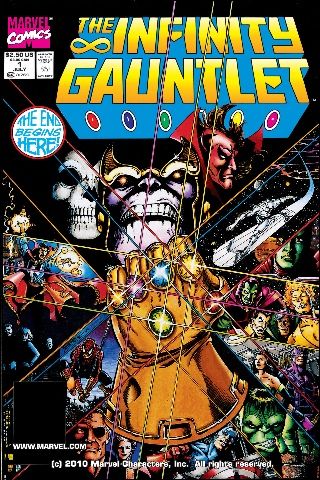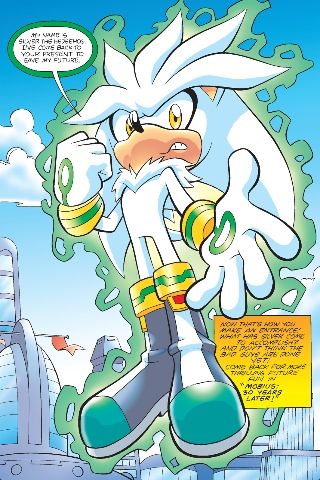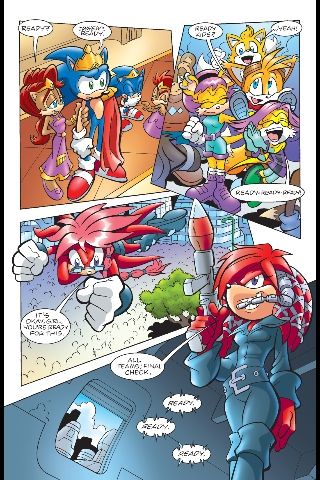Away From The Shop #2: Jeff Talks About Digital Releases, Infinity Gauntlet & Sonic Universe #5
/Hey, Jeff again. So, sooner or later, I'm going to end up talking about actual comics, purchased from an actual comic book shop. (Considering this blog is run by a comic shop owner, I'm sure Hibbs would really appreciate that.) But I kinda figured I'd take a few minutes to talk about some of my recent experiences with digital comics and like-that. Should you be interested, reviews and context for Infinity Gauntlet and Sonic Universe are behind the cut. First thing's first: I'm reading my digital comics on my iPhone 3GS. I've only had the 3GS for just under six months (I used a first gen iPod Touch for years before that) and, as everyone says, it's clearly not the ideal way to read your comics. In fact, it's pretty hard to talk about the experience with friends as they tend to fall mostly into two groups--the "Ugh, I would never read digital comics" group and the "Ugh, I would never read digital comics on an iPhone group" who then go on to get all dreamy-eyed while they talk about their iPads--neither of whom ever really let me get past their respective rants.
So, yeah: reading comics on your iPhone is not ideal. On the other hand, as a child of the '70s, some of my fondest memories are reading comics in less than ideal conditions. Remember those trade paperbacks that reprinted the Roy Thomas/Barry Smith Conan stories in black & white, with approximately two panels per page? I read those. Remember that Don Martin Captain Klutz paperback where the stories were reprinted at a single *panel* per page? I read that. Remember going into the used bookstore and finding the first thirty pages of a Savage Sword of Conan with the cover torn off jammed between a bunch of old National Geographics? I read that too, and it was pretty god-damned awesome.
I admit it, I had the Comixology app on my iPod Touch and I used it sparingly, mainly to collect free issues of books I thought I'd try out (and review here) but then never got around to reading 'em. The turning point was a recent vacation to Vegas where I figured I'd grab something to read on the iPhone. And just as I decided I'd do so, what would end up getting released on the Comixology app but...
INFINITY GAUNTLET #1-6: I had fond memories of the first issue or two of Infinity Gauntlet although it was something I'd never bought in the store for some reason (probably it came out during one of those times I was taking a time-out from the Big Two) and the idea of reading it on my phone really cracked me up: all those double-page spreads of universes being destroyed, jammed onto a screen almost the size of an american cheese slice! But something about seeing that near-classic cover of Thanos holding up the Infinity Gauntlet, the glove that gives the wielder the power of a god, twanged some primal chord within me and I figured it was worth ponying up $1.99 twice to give the first two issues a whirl.
Since the first few issues are by George Pérez, inked by Ron Lim (a situation that reverses in the later issues, by the way, which is an interesting way to solve the problem of shipping on time while keeping the book looking consistent), [EDIT: eagle-eyed reader BobH points out that, in fact, it was Joe Rubenstein doing the inking over first Pérez and then Lim. Thanks, Bob!] the art in Infinity Gauntlet makes it seem like something from the recent past instead of nearly two decades gone by, thanks to the strong Pérez influence on Infinite Crisis. Like it or not, George Pérez is the go-to man for superhero apocalypses and the early issues of Infinity Gauntlet make it clear why--not only is he game to drawing dozens of characters and working in little in-jokes and nods to classic continuity at the same time (I'm assuming it was Pérez who took the time to list all the names of the Sons of the Tiger, one of his first professional gigs, on a handbill in a street scene), he has a dynamic sense of layout and panel rhythm that keeps the start of Infinity Gauntlet from being a turgid slog of exposition.
Interestingly, one of Pérez's big weakness for me--jamming so much detail into a page that it can't breathe--was mitigated by reading the issues on the iPhone: the guided-panel practice keeps the eye from getting overwhelmed. Although there's a good case to be made that a reader picks up an event book by Jim Starlin and George Pérez precisely with the intention of being overwhelmed, I still found myself charmed by how Infinity Gauntlet on the iPhone ends up being a slide show of Starlin's greatest hits--Thanos, Warlock and Pip The Troll all appear, and I believe reality gets entirely wiped out at least twice. The story is pretty easy to pick apart and doesn't really have the snap that Starlin had in his early period, but I found it a GOOD read, even on an iPhone, although perhaps you should factor in my Marvel/Starlin fanboy nature, and the fact that I was on a plane with a few drinks in me.
(By the way, I admit that because this was the first comic I really *read* on the iPhone, I was stubborn enough to push through on my conversations with my respective groups of friends, allowing me to pass on this tidbit to anyone at Marvel who might be reading: everyone I talked to remembers Infinity Gauntlet with lesser and greater degrees of fondness, but everyone adored* The Thanos Quest, the preceding two issue miniseries where Thanos tricks, cajoles and forces the gems out of the hands of the Elders of the Universe who possess them. Those two issues on an iPad? That would put some money in your pocket, Marvel. )
SONIC UNIVERSE #5: This comic book is a kick in the slats to anyone who insists that the reason why more kids don't read comics is that superhero books are too insular. Sonic Universe #5, after all, is a book where Sonic the Hedgehog, twenty-five years later after, uh, something, has been made king of a city of hedgehogs, I guess, and has two kids and spends most of his time looking mopey and vaguely constipated while this female hedgehog (I...think?) in granny glasses alternately babysits his kids and beats up extremists attempting a coup. And Tails has a wife (who's a...rock star?) and two kids, and there's talk about "The Chaotix," and at the end an assassination attempt is foiled (spoiler!) by the sudden appearance of Silver The Hedgehog, who has "come back to your present to save my future."
Honestly, it's just as tall a cup of "what the fuck" as anything DC or Marvel have been serving up, and all of the characters and situations had to be already familiar to the reader of the book in order to have any emotional resonance whatsoever. Without that familiarity, it's twenty-nine pages of "U R A NOOB LOL".
I'll be honest: I picked up Sonic Universe #5 in no small part because I wanted to be thrown into the deep end of the pool (and also, "King Sonic" reminded me of "King Conan," and the idea of this videogame character having a similarly storied history tickled me) and that's certainly what I got, though it took no more than two or three visits to Wikipedia to get everything I needed to make enough sense of stuff. (Although, thanks to haphazard story input from different teams of game developers every time there's a new Sonic game--including taking existing elements put forth in the comics and twisting it--the Sonicverse would give the DCU a run for its money in sheer palimpsestry, so frequently have certain characters been introduced and re-introduced with purposes and origins utterly at odds with their previous appearance.)
So I'm actually quite pleased I had to put in some effort, even if I felt the results weren't necessarily worth it. In a way, what Sonic Universe #5 reminded me of most was Superman's silver age Imaginary Stories, where you get to see characters married and mopey and vaguely constipated, and the calamities that inevitably arise from that that...except those stories didn't run for six issues at a dollar a pop. I wonder, though, if that problem is as much one of the state of our medium as much as it is the industry. Although the art in Sonic Universe isn't going to be mistaken for George Perez anytime soon, the panel layout, story progression, and verbal-visual blend are modern, essentially the same as what you'd see in a DC or non-Bendis Marvel comic.
Now, one of the things that fucking sucks about being 44 is that you find yourself having to qualify everything with--"okay, this may just be empty nostalgia on my part"--but, well, okay, while this may just be empty nostalgia on my part, I'm starting to think that although DC's silver-age six panel grid and Marvel's hyper-talky panels were technically bad comics, they were highly efficient deliverers of story, particularly within the limitations of their given page count: you got the set-up, you got the action, *and* you got a deluge of information, chatter, exposition, until you got something that clicked with you.
Actually, as long as I'm chasing myself down this theoretical hidey-hole, let's talk about a crucial theory in Scott McCloud's Understanding Comics, that of cartooning's iconic nature. McCloud's theory--that the abstract nature of a cartooned face, for example, becomes "an empty shell that we inhabit"--is a really efficient way of talking about what happens when we look at comics, and he notes the way in which cartooning and photorealism are used in various ways to give a visual sense of "self" and "otherness" in a narrative. What I'm wondering about, looking at Sonic Universe #5 and the beloved Marvel comics of my youth, is the way in which story detail mirrors these purposes. As kids, the first stories we hear and see are very simple, fairy tales, fables--stories that, like cartoons, are empty enough that we fill them with our nature. But as we age, there comes a point as a reader where a child desires the other; not so much from the story's characters--those are pretty much the same old heroic seeker/lost innocent figures from the fairy tales--but from the story itself. It has to be baroque, filled with dozens of characters, side-characters, references to previous and past events. The world of the fiction is a simulacrum of the real world as the child has begun to become aware of it--filled with people and history and tumult. And the thing that is most important to the child is that the milieu and the plot be sufficiently complex to the point of, well, badness.
Tolkien's Ring Trilogy; Howard's Conan books; Stan Lee's speech balloons; Superman Red and Superman Blue: all of those things can be appreciated by most critics as having some kind of value--"better than most of their ilk" is the way they get described by the literary-minded critic--but the reason why they were popular isn't what makes them "better." It's precisely their worst tendencies--characters barely able to scrape together two-dimensions set loose in a florid rococo universe where everyone's mouths spill out endless exposition--that made them popular, and what led to Robert Jordan books and Gor novels and Infinity Gauntlet and Blackest Night and enough fucking volumes of Harry Potter to stone someone at the town square. I submit there is a point in the development of the reader, the viewer, the audience, where their needs and desires are directly in opposition to good storytelling and good art.
Interestingly, when indulged to its extreme, this way in which a maturing reader tries to engage with the world, when endlessly indulged, results in works so complex and so impenetrable (to others) that the work ends up operating contrary to its initial purpose: it isolates the reader from the real world, rather than introducing them to it. The work ends up swaddling the reader like a papoose, making them comfortable, but still separate and even more isolated than before. Or at least so it was until the Internet, such that lovers of "bad" fiction from all over the world were able to come together and connect and swap the kind of fanart that makes SafeSearch such a blessing.
Now if I was of a more David Foster Wallaceian bent, I'd walk you through the ramifications of that idea--of how the Internet seems to triumph over that isolationism and join like-minded lovers of imaginary worlds but in fact is itself something of an isolating swaddle, a thing that binds us and keeps us from fully participating in the real world. If I was of this bent, I would point to the number of people who end up disappearing down their own hidey-hole of WoW and catassery, the growing numbers of 'hikikomori' worldwide, or just the times in your own life you've felt chained to your computer, to the Internet, aware that you should be walking away from it and spending time with your loved ones or just going for a quick motherfucking walk outside, rather than continuing to tumble through the branches of the Internet, half-falling, half-seeking, the line between heroic seeker and lost innocent almost savagely blurred. The Internet is a bad work of genre fiction in a way, something that indulges us to our detriment, giving us far too many opportunities to look for what we want and not nearly enough chances to find what we need, connecting us in non-space at the sacrifice of how we live in real space.
But, as much as I love David Foster Wallace, the guy could be a bit of a prig. The tightrope act we walk, balancing between the lives we live in our heads (or in our books) and out in the real world, must be a routine literally as old as human consciousness. Comic books, genre fiction, and the Internet are just the bowling balls, fiery pins, and chainsaws we've introduced into to keep the juggling act interesting. (Also, maybe that first stone should be cast at the Internet by someone who didn't just spend more than two thousand words writing about two comic books.)
In the end, if I have a complaint about Sonic Universe #5, it's not that it's bad. I guess my complaint would be that it isn't bad enough: if you're not going to have the clarity and elegance of Carl Barks going for you, at least get your hands dirty and overpower my attention span such that I *needed* to hunt up those back issues, rather than feeling obligated to hit Wikipedia for the sake of a balanced review.
That said, whoever the heck that hedgehog with the granny glasses is, it's a safe bet she's not going to end up in a refrigerator any time soon--nor will any of the Sonic characters--so that alone makes it highly OK or better if you're looking for a book to get your kid interested in...though you might rate it higher or lower, depending on how good you want your bad to be. This may just be empty nostalgia on my part but I think I almost prefer the days when the bad was better than it is now, because it made it that much harder to confuse the good for the great.















